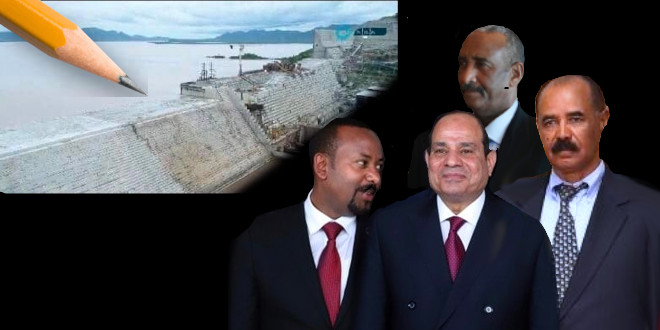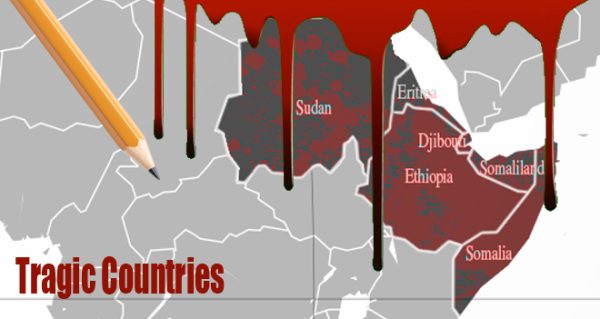Dam On The River Nile

The Horn of Africa region saw two weeks of hectic travels. And Eritrean officials travelled the most. If the leaders were enrolled in a travel-miles program they would have accumulated so many travel credit.
On June 25, Isaias visited Sudan and met Abdelfattah AlBurhan, the Chairman of the Transitional Military Council. And on July 6, he travelled to Cairo and met President Abdelfattah AlSisi of Egypt. On July 18, PM Abiy Ahmed of Ethiopia travelled to Asmara and met Isaias Afwerki. And on July 19, General Filipos Weldeyohanes, the Eritrean Chief of staff, visited Sudan leading a delegation of three other Eritreans generals who met their Sudanese counterparts. It was the first time the official Eritrean media gave prominence to official travels other than Isaias’ and the duo of Osman Saleh, the official Foreign minister and Yemane Gebreab who is widely known in Eritreans circles as “the chaperon of the foreign minister.”
Isaias is Abiy Ahmed’s Kefeel
The Arab Gulf countries have a sponsorship regime; all expatriate workers are required to have a Kefeel, (sponsor) who controls their movements, allows or disallows them to change their workplace, holds their passports, and signs approval documents to enable them to get exit visas, driving licenses, and even to rent a house. Isaias has positioned himself as Abiy’s sponsor in the royal floors of the UAE and Saudi Arabia.
Abiy is a “new-bie” in the region, with no experience in dealing with the Arab Gulf diplomatic culture. On the contrary, Isaias is thirty years older than Abiy, and is versed in Arab political culture. Abiy must be excited to have an able godfather as Isaias. but Isaias, now seventy-four years old, believes Abiy is a “malleable, ambitious colonel”. And having him close is a golden opportunity that helps him to find cracks through which he can sneak into Ethiopian politics.
As soon as Isaias secured a place in the new alliance with Saudi Arabia and UAE, he abruptly dropped his Qatari sponsors of many years. The switch was smooth as the Saudi-UAE alliance was frantically buying support for its “Operation Destroy Yemen and Qatar” which it launched in 2015. And Isaias found a seat beside Egypt’s Al Sisi who was already onboard the Saudi-UAE coach. Isaias took the assignment to sponsor Abiy because Saudi Arabia, the UAE, and Egypt were more interested in Ethiopia and the Nile politics than Qatar was.
However, as the war in Yemen dragged on, the Saudi-UAE coffers were fast emptying and unprecedented financial crisis was looming over the Arab Gulf since the region has become a fertile ground for the ambitions of MBS of Saudi Arabia and MBZ of the UAE. They have been pounding Yemen since 2015 and still going at it. Yet, they are still engaged in Libya where a serious confrontation with Turkey is on a pressure cooker.
In the Horn of Africa, Abiy Ahmed and Isaias have cemented an alliance to destroy the TPLF, the ruling party of the northern Ethiopian region of Tigrai. The region’s military bellows are keeping the fires that consumed the region alive. And the never-ending feud rages on though it has already claimed the lives of tens of thousands of soldiers, forced more than that to seek refugee all over the world and froze development. So far, the war is being escalating in the media, but it could easily flare up and result in an all-out war.
Dam On The River Nile
The conflict between Egypt and Ethiopia was on the right path until it got more fuel in the beginning of the year. One reason was the Covid 19 induced tremor, the other was internal anxiety and public dissatisfaction in both countries. While Egypt faces popular dissatisfaction, Ethiopia faces civil strife and political turmoil. Both Al Sisi and Abiy Ahmed used the Dam on The River Nile dam as a diversion of the public anger. Egyptian activist and trolls became loud while the official talking-heads overbid each other to appear more nationalistic and more pro Al Sisi. At the same time, while Ethiopians activists resorted to mythologies and awakened the demons of anti-Egyptian rhetoric, while racist Egyptians resorted to cheap propaganda.
Interestingly, many Arabic speaking Ethiopians who were traditionally absent from the political scene, effectively swarmed the Social media platforms serving the Egyptian talking heads what they gave. Thus, virtual populist fight over the Dam on The River Nile is raging on a battleground provided by Facebook and YouTube. Neither Isaias nor Abiy liked it; they didn’t like were that might lead. But AlSisi liked it since it was an excellent tool he can use as he mobilizes Egyptians to invade Libya and depose the internationally recognized government. The Saudi-UAE block wants to install Khelifa Hafter, the renegade retired Libyan general after AlSisi overthrows the Libyan government. However, Turkey is backing the internationally recognized Libyan government, and overthrowing it has proven to be difficult and costly for the Saudi-UAE block. But that story keeps branching out endlessly. Every country in the region from Algeria in the West, to the UAE in the East is involved in Libya in one way or another.
Where Did All That lead?
Isais travelled to Cairo to convince AlSisi to cool down the Egyptian rhetoric on the Nile issue with Ethiopia and said that Abiy was already contemplating pulling the plugs from the Internet. He also cautioned him to stop anything that might weaken Abiy Ahmed because his replacement would be more nationalist and uncompromising with Egypt. Of course, that wouldn’t be good for the long-term plans of the Saudi-UAE led alliance.
On July 18, Abi traveled to Eritrea to be briefed on Isaias’ meeting with Al Sisi in Cairo; Isaias assured him AlSisi has agreed to cool down and he must handle the Nile issue carefully.
Isaias’ advice to AlSisi, in addition to the shock of the start of filling of the Ethiopian dam, sent tremors all over Egypt whose talking heads have remarkably slowed down though the runaway social media activists are still at it. But Ethiopia pulled the plug on the internet and suffocated the local activists, though the diaspora is still active demonstrating against the prevailing political and security situation in Ethiopia. In one American city, the Ethiopian demonstrations were so crowded that some people mistook it for the Black Lives Matter protests.
But now the Ethiopian Internet is reconnected, and activists have resumed their work cautiously. But when the Internet was shutdown, hundreds of civilians were murdered, many properties were destroyed, and thousands of people were arrested. And during the last week, daily doses of disturbing and gruesome images of mutilated bodies, violence and lawlessness appear on social media overwhelming Ethiopian and Eritrean platforms. Meanwhile, the mayhem is continuing unabated in many parts of Ethiopia.


Awate Forum